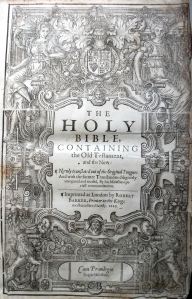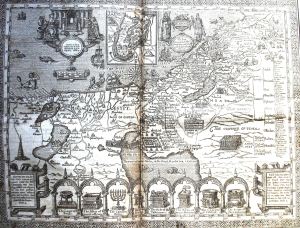Most of us love rummaging around in antique shops, dreaming of discovering something valuable amongst the assorted items of furniture, worn paperbacks and bric-a-brac. Well, several years ago Trinity Hall alumnus Bill Cave was actually lucky enough to make an amazing find.
There, in the bottom of a cardboard box in a dusty corner of a junk shop in the Lake District, was a tatty looking Bible. Still in its original (much worn) binding, the volume could have been easily overlooked but it was something special and Bill Cave recognised its value immediately. It was an early edition of the King James Version of the Bible (KJV), printed by John Barker, the King’s printer, in 1616. This year is the 400th anniversary of the KJV and this copy of the Bible has been recently on exhibition where it was valued at over £2,000 for insurance purposes. We are now extremely fortunate to receive it as a gift to add to the Old Library’s collection.
In 1604 King James I initiated a new translation of the Bible at the Hampton Court Conference. While the translators worked from the Hebrew for the Old Testament, Greek for the New Testament and Greek and Latin for the Apocrypha, they also drew on previous translations (the Tyndale, Coverdale and Geneva Bibles). Also known as the “Breeches Bible”, the Geneva Bible was the primary Bible of the Protestant movement and its language influenced William Shakespeare as well as the translators of the Authorized Version. First published in 1611, the KJV became tremendously popular and by the first half of the 18th century it was the English translation most widely used by the Anglican church. The language of the King James Bible has become embedded in the psyche of the English, influencing many writers from Milton and Ruskin right up to the present day.
Our copy of the Bible is bound with John Speed’s The genealogies recorded in sacred scriptures. This work contains 34 pages of lively woodblock prints of genealogical trees of Biblical figures and a magnificent double page map of the Holy Land.
In addition to the Bible, Bill Cave has also presented us with three books by his distant ancestor and namesake, Rev. William Cave (1637-1713): the Lives of the Fathers volume 1 and volume 2 (1682-1683) and the Lives of the Apostles (1684). Educated at St John’s College Cambridge, William Cave started his career as vicar of St Mary’s, Islington (where he is buried) and rose to be Chaplain in Ordinary to Charles II and canon of Windsor. He certainly moved in posh circles! His scholarship focussed principally on the early church and is distinguished by the lucidity of its arrangement, making his volumes standard texts for several centuries. These three volumes, treasured family presents to Bill Cave some 20-30 years ago, have now joined another work by Cave already in our collection, Scriptorum ecclesiasticorum historia literaria, which was published in two parts (1688-1698). They have now found a permanent home in the Old Library where they are available to scholars and will be cared for in the future.
Additional information:
There is currently an excellent exhibition on the making of the King James Bible, “Great and manifold blessings” in the University Library which is on until 18 June 2011.

Hurry! This exhibition finishes on 18th June
Ruskin scholar, Clive Wilmer, gave an excellent talk on Ruskin and the King James Bible on 10th May 2011. For more on Ruskin’s Bible reading see Wilmer’s article ‘Ruskin and the Sense of an Ending: Apocalypse and Literary Form’ in Ruskin’s Struggle for Coherence: Self-Representation in Art, Place and Society, eds. Rachel Dickinson and Keith Hanley (Newcastle: Cambridge Scholars, 2006).
Information on Rev. William Cave, Chaplain in Ordinary to Charles II, was taken from Wikipedia and there is also an article on him in the Oxford Dictionary of National Biography (for those who have access to this online database).




